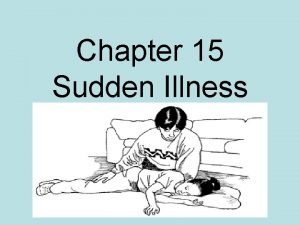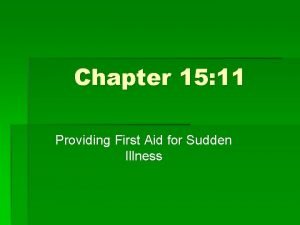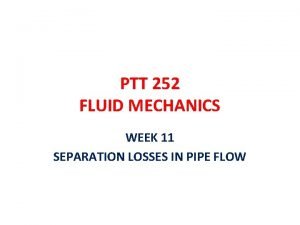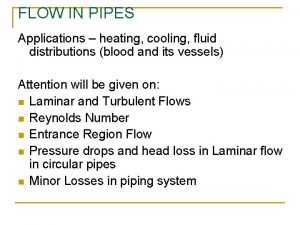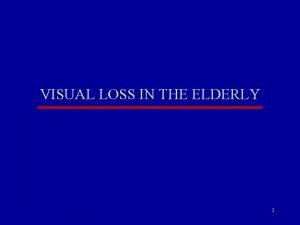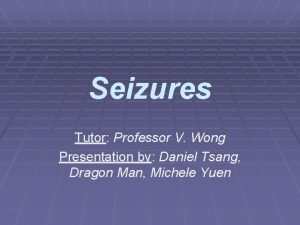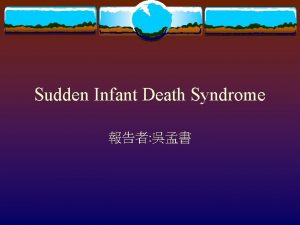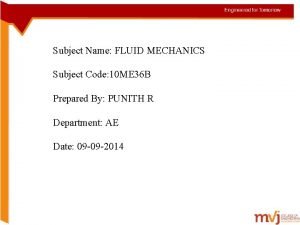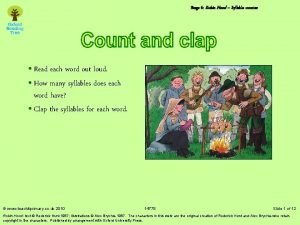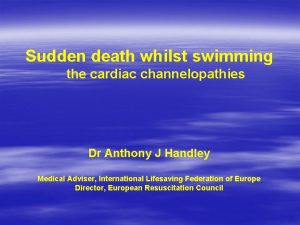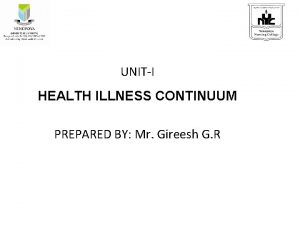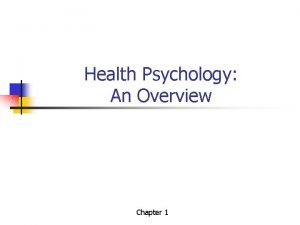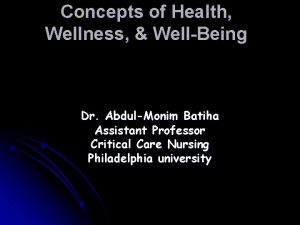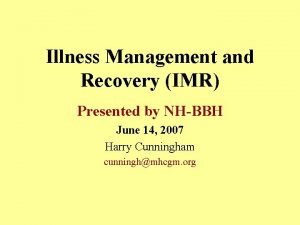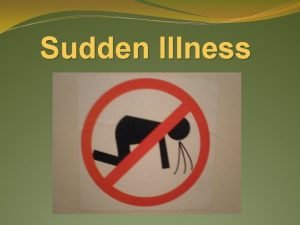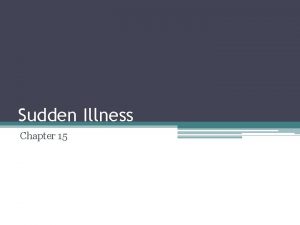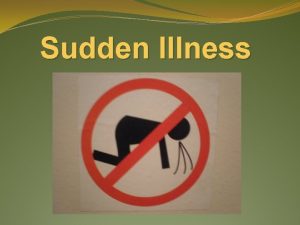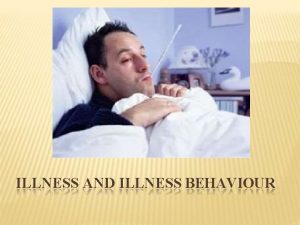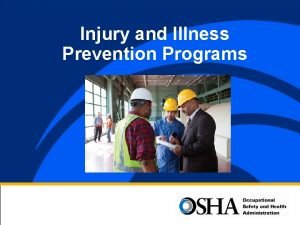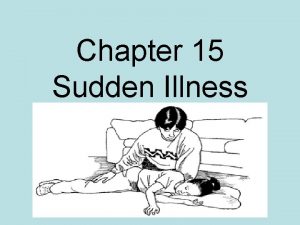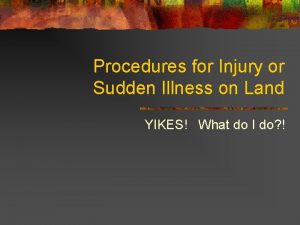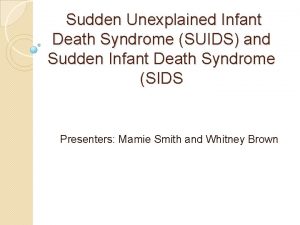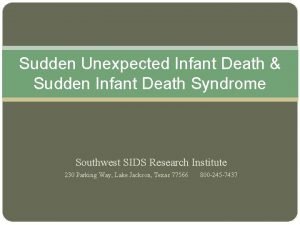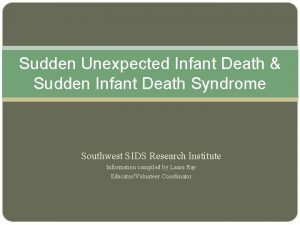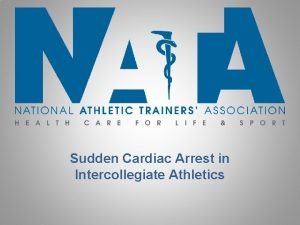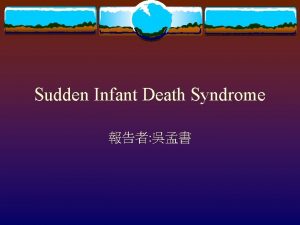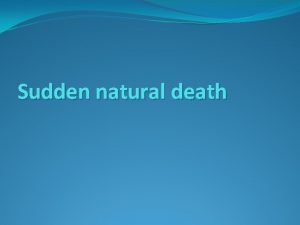SUDDEN ILLNESS AND INJURY Although there are many











































- Slides: 43

SUDDEN ILLNESS AND INJURY Although there are many different types of sudden illnesses, they often have similar signals. Care for any life threatening conditions first! Do not second guess Call 911 3/9/2021 SUDDEN ILLNESS AND INJURY 1

• • • • • VOCABULARY SEIZURE CONVULSIONS FAINTING AURA DIABETES LYME DISEASE HYPOTHERMIA FROSTBITE GANGRENE POISON VOMIT DIARRHEA EPILEPSY FEBRILE DEGENERATIVE DISEASE LIFE EXPECTANCY DEPRESSION CROUP 3/9/2021 • • • • • INSULIN HYPERGLYCEMIA HYPOGLYCEMIA STROKE DISORIENTED INJECTION TOXIC CARBON DIOXIDE CARBON MONOXIDE INGESTION INHALATION ABSORPTION HEAT STROKE HEAT CRAMPS HEAT EXHAUSTION HYPERTHERMIA ALZHEIMERS DISEASE EPIGLOTTIS SUDDEN ILLNESS AND INJURY 2

Recognizing Sudden Illness • • Signals are confusing Changes in consciousness Feeling light-headed: Dizzy Nausea and diarrhea Numbness or paralysis Unconsciousness When in doubt call 911 3/9/2021 SUDDEN ILLNESS AND INJURY 3

POISONING • A substance that causes injury or illness • Some poisons are deadly • Reactions to poison are more serious in children • Different people react differently to various poisons • Poison control centers can be reached 24 hrs/day 3/9/2021 SUDDEN ILLNESS AND INJURY 4

METHODS OF POISONING • • INGESTION INJECTION ABSORPTION INHALATION 3/9/2021 SUDDEN ILLNESS AND INJURY 5

FACTS ABOUT POISONINGS • Between 1 -2 million poisonings occur each year • More that 90% take place in the home • Most poisonings happen to children under 5 • Poisoning deaths in children have gone down • Poisoning deaths in adults have gone up 3/9/2021 SUDDEN ILLNESS AND INJURY 6

POTENTIAL POISONS • • • FOODS MEDICATIONS ASPRINS MUSHROOMS SHELLFISH CLEANING PRODUCTS PESTICIDES CERTAIN PLANTS USING AND ABUSING CERTAIN DRUGS TRANQUILIZERS, SLEEPING PILLS AND ALCOHOL 3/9/2021 SUDDEN ILLNESS AND INJURY 7

SIGNS AND SYMPTOMS • • • Burns or stains around patients mouth Unusual breath or body odors Abnormal pulse rate Dilated or constricted pupils Excessive saliva formation or foaming at mouth Painful swallowing Abdominal pain Profuse sweating Nausea, vomiting, diarrhea, Convulsions 3/9/2021 SUDDEN ILLNESS AND INJURY 8

INHALATION POISONING • • • Breathing toxic fumes Gases such as CO 2 found in sewers and wells Chlorine found in swimming pools Fumes from glues and paints Chemical household products Ammonia Industrial solvents Volatile liquid chemicals Drugs such as crack and cocaine 3/9/2021 SUDDEN ILLNESS AND INJURY 9

Signs and Symptoms of Inhalation Poisoning • Respiratory distress • Cyanosis of the skin, lips, nailbeds, tongue or earlobes • Headache and dizziness • Shortness of breath • Coughing • Irregular pulse rate • Irritated eyes 3/9/2021 SUDDEN ILLNESS AND INJURY 10

Care for Victims of Inhalation Poison • Do not rescue victim from poisoned environment if scene is not completely safe • Remove victim from source of inhaled poison and smoke free area • Perform a patient assessment and provide life-support needed • Place victim in sitting or semi-sitting position if no head or neck injuries • Remove any contaminated clothing and jewelry • Provide care for shock 3/9/2021 SUDDEN ILLNESS AND INJURY 11

ABSORBED POISONS • Usually irritate or damage the skin or eyes • Poison is absorbed through the skin • Skin irritations range from mild to severe chemical burn • Itching • Headache • Increased skin temperature • Anaphylactic shock 3/9/2021 SUDDEN ILLNESS AND INJURY 12

Care for Absorbed Poisons • Move victim for source of poison if scene is safe • Plants, poison ivy, poison oak, fertilizers and pesticides • Flood patients body with water • Remove contaminated clothing etc. • Wash affected areas with soap and water 3/9/2021 SUDDEN ILLNESS AND INJURY 13

INJECTED POISONS • • Insect stings, spider bites, marine life stings Black widows and brown recluse spiders bites can be fatal Tick bites can cause Lyme Disease Snakebites Hypodermic needle injections of street drugs Human bites Animal bites Be alert for anaphylactic shock 3/9/2021 SUDDEN ILLNESS AND INJURY 14

SIGNS AND SYMPTOMS OF INJECTED POISONS • • • Noticeable stings or bites to the skin Puncture marks to the skin or extremities Pain around wound site Itching Weakness, dizziness or collapse Breathing difficulty Irregular pulse rate Headache Nausea Anaphylactic shock 3/9/2021 SUDDEN ILLNESS AND INJURY 15

Care For Injected Poison • Contact Poison Control Center or • EMS to get directions for care • Provide care for shock even if anaphylactic shock is not suspected • Scrape away bee stings and venom sacs • Do not pull out stingers • Place ice bag or cold pack over bitten or stung area SUDDEN ILLNESS AND INJURY 3/9/2021 16

SNAKEBITES • • • Thousands are bit by poisonous snakes in the U. S. yearly Fewer than 10 deaths are reported yearly Signs and symptoms take several hours to develop Death takes @ 1 -2 days to occur Consider ALL snakebites poisonous Signs include noticeable bite to skin or obvious discoloration Pain and swelling Weakness Vision problems Rapid pulse and labored breathing Nausea and vomiting 3/9/2021 SUDDEN ILLNESS AND INJURY 17

Care For Snakebite • • Keep patient calm and lying down Activate EMS Wash fang marks with soap and water Remove constricting jewelry Immobilize bitten extremities Keep bitten area below heart Provide care for shock Monitor vital signs 3/9/2021 SUDDEN ILLNESS AND INJURY 18

INGESTED POISONS • Signs and symptoms of ingested poisons can be seen during the patient assessment • Burns or stains around victims mouth • Unusual breath, body or surrounding odors • Abnormal breathing • Irregular pulse • Sweating • Dilated or constricted pupils • Painful swallowing • Abdominal pain, nausea, vomiting, diarrhea • Convulsions • Altered states of awareness, including unconsciousness 3/9/2021 SUDDEN ILLNESS AND INJURY 19

Care For Ingested Poisons • Always call poison control center to get antidote • Maintain open airway • Dilute the poison with water or milk only if patient is not convulsing • Give activated charcoal if directed • In case of vomiting, place victim on side • Save all vomitus • Provide care for shock • Provide O 2 if appropriate 3/9/2021 SUDDEN ILLNESS AND INJURY 20

SEIZURES • Brain is disrupted by injury, disease, fever, or infection • Electrical activity of brain is irregular and causes loss of body control • Caused by extreme heat, fever, diabetes or brain injury • Epilepsy a condition that causes seizures and controlled by medication • Seizures range from mild blackouts to uncontrolled muscular contractions and convulsions • Convulsions can last from 2 -5 minutes with complete loss of consciousness and muscle spasms • An aura is something one experiences 3/9/2021 SUDDEN ILLNESS AND INJURYprior to having a 21 seizure

Care For Seizures • • • Do not hold or restrain victim Do not place anything in victim’s mouth Do not hold victims mouth-it cannot be swallowed Do not give liquids nor rescue breathing Remove nearby objects that might cause injury Cushion victim’s head using folded clothing etc. or small pillows 3/9/2021 SUDDEN ILLNESS AND INJURY 22

FAINTING OR PSYCHOGENIC SHOCK • A common signal of sudden illness is losing consciousness • Insufficient supply of blood to the brain for a short period of time • Blood vessels widen which causes blood to drain away from brain • Usually victim of fainting will recover quickly with no lasting effects • It may be signal of a more serious condition • Place victim on back, elevate feet 8 -12”, loosen restrictive clothing 3/9/2021 SUDDEN ILLNESS AND INJURY 23

SIGNS AND SYMPTOMS OF STROKE • Sudden weakness or numbness of the face, arm, leg or on 1 side of body • Loss of speech or trouble speaking • Dimness or loss of vision • Unexplained dizziness • Severe headache • Loss of bladder or bowel control • @ 10% are preceded by little strokes TIA’s • Transient Ischemic Attacks 3/9/2021 SUDDEN ILLNESS AND INJURY 24

CEREBROVASCULAR ACCIDENT Third leading cause of death in America • Major cause of disability • Blood vessel in brain becomes clogged or bursts • Prevents blood vessel carrying O 2 and nutrients from reaching brain cells • FIRST AID FOR STROKES • Patient assessment • Place victim on paralyzed side down • Keep head slightly elevated • Nothing by mouth • Eyelids should be taped shut to prevent loss of vision due to drying 3/9/2021 SUDDEN ILLNESS AND INJURY 25

DIABETES • Leading cause of death in US killing thousands • Inability of pancreas to metabolize carbohydrates • Body is unable to properly convert sugar from food into energy • Insulin is the hormone that enables blood to absorb sugar and formulate glucose • Thus an imbalance of insulin and sugar in body or blood • Lack of insulin creates starvation of the cells • Can lead to blindness, kidney disease, heart attack and stroke 3/9/2021 SUDDEN ILLNESS AND INJURY 26

Signs and Symptoms of Diabetes • TYPE 1 is Unexpected weight loss, irritability, weakness, juvenile onset and daily injections of insulin are needed • Pancreas’ inability to produce insulin • Increased urine output, hunger, and thirst and fatigue • TYPE II is most common type affects @ 90% of individuals with diabetes • Adult onset caused by obesity • Changes in levels of consciousness • Rapid breathing and pulse • Feeling and looking ill • Victims appear intoxicated, angry, pale, confused, disoriented, sweating, eventual stupor or unconsciousness 3/9/2021 SUDDEN ILLNESS AND INJURY 27

SIGNS AND SYMPTOMS OF HEART ATTACK • Severe chest pains, tightness, fullness, pressure or squeezing sensations • Pain that radiates in arms or jaw • Feelings of indigestion • Nausea • Respiratory distress • Sweating • Restlessness • Denial 3/9/2021 SUDDEN ILLNESS AND INJURY 28

CARE FOR HEART ATTACK VICTIMS • • Place victim in comfortable position Activate EMS Provide emotional support Loosen restrictive clothing Maintain body temperature Monitor vital signs If appropriate assist victim with medications 3/9/2021 SUDDEN ILLNESS AND INJURY 29

BATTLING THE ELEMENTS • Conditions related to heat or cold can get progressively worse and result in death • Any extremes in temperatures are life threatening • People at risk include: • Those who work or exercise outdoors • Athletes • The elderly • Young children • Individuals with health problems • Medical problems that lead to poor circulation • Those who take diuretics 3/9/2021 SUDDEN ILLNESS AND INJURY 30

EXCESSIVE HEAT • Heat Cramps - caused by profuse sweating resulting is salt depletion and dehydration • Heat Exhaustion - a form of shock caused by severe loss of fluids and minerals • Heat Stroke - body’s temperature regulating mechanisms fail and is life threatening • Hyperthermia 3/9/2021 SUDDEN ILLNESS AND INJURY 31

SIGNS AND SYMPTOMS OF HYPERTHERMIA • • • Red, hot, dry skin Severe muscle cramps in legs or abdomen Exhaustion to point of collapse Dizziness or periods of faintness Rapid, shallow breathing Weak, irregular pulse Heavy perspiration to no perspiration Large dilated pupils Weakness Convulsions or muscular twitches May have loss of consciousness or go into coma 3/9/2021 SUDDEN ILLNESS AND INJURY 32

CARE FOR HYPERTHERMIA • • Activate EMS Remove victim from the heat Remove sweat soaked clothing Loosen tight garments Apply wet, cool cloths, towels, or sheets Give cool liquids slowly if victim is conscious 4 oz. Every 15 minutes Monitor vital signs 3/9/2021 SUDDEN ILLNESS AND INJURY 33

HYPOTHERMIA • Cold related illness ranges from severely cold weather to frostbite • Severity depends on air temperature • Length of exposure and wind chill factor • Frostbite is the freezing of body parts exposed to cold • Feet, hands, ears and nose are most vulnerable • These areas do not contain large heat-producing muscles • When body conserves heat, the blood supply diminishes in these areas first • Gangrene and amputation are probable 3/9/2021 SUDDEN ILLNESS AND INJURY 34

SIGNS AND SYMPTOMS • Shivering seen in early stages • Feelings of numbness and increases as hypothermia worsens • Drowsiness and lack of interest • Rapid breathing and rapid pulse • Slowing of breathing and pulse as conditions worsens • Joint and muscle rigidity • Loss of coordination and ability to hold objects • Unconsciousness • Freezing of body parts 3/9/2021 SUDDEN ILLNESS AND INJURY 35

CARE FOR HYPOTHERMIA • • • Perform patient assessment Activate EMS if necessary Move victim out of the cold Remove wet clothing Wrap the victim in blankets Maintain body temperature Place frozen body parts in warm water 102 -105 degrees Warm for about 20 -40 minutes, never rub frozen body part Continuously monitor vital signs Treat for shock 3/9/2021 SUDDEN ILLNESS AND INJURY 36

CARING FOR THE YOUNG • • • Children are not simply small adults They have special needs and require special care One of a child’s strongest emotions is fear Infants 0 -1 develop “stranger anxiety” and become uncooperative Toddlers 1 -2 are frequently uncooperative clinging to parent or guardian • Preschoolers 3 -5 are usually cooperative and naturally curious • School-age 6 -12 are usually cooperative and give information easily • Adolescent 13 -18 are modest and usually respond better to a caregiver of the same gender • They are normally cooperative • Injury is #1 cause of death for children in US many are the result of 3/9/2021 SUDDEN ILLNESS AND INJURY 37 motor vehicle accidents

PROBLEMS RELATED TO CHILDREN • • Blocked airway and bleeding Head injuries due to size of head in proportion to rest of body Injuries due to lack of proper safety precautions -seatbelts High fevers or a febrile condition above 103 degrees f. . Seizures Infections that affect breathing Croup is a swelling of pharynx below larynx resulting in a cough that sounds like the bark of a seal • Epiglottitis is the severe inflammation of epiglottis, epiglottis a flap of tissue above larynx that protects airway during swallowing • Swelling can occur to point of airway obstruction 3/9/2021 SUDDEN ILLNESS AND INJURY 38

CHECKING A CHILD • • Observe the child before touching him or her Remain calm Communicate clearly with the parent of guardian Do not separate the child from loved ones unless necessary Gain trust through your actions Activate EMS for any life threatening conditions To care for a child who is having trouble breathing place in comfortable position • For croup of epiglottitis exposure to cool air from outdoors or cool steam from a vaporizer 3/9/2021 SUDDEN ILLNESS AND INJURY 39

TODAY’S ELDERLY • The elderly are generally considered those over 65 • This is the fastest growing population group in the United States- ages 86 and up • Major reason is an increase in life expectancy due to improved health care • Many changes occur with age due to declines in bodily functions beginning as early as age 30 • Heart and lung functions decrease thus circulation is impaired • Brain shrinks and sight and hearing are diminished 3/9/2021 SUDDEN ILLNESS AND INJURY 40

ELDERLY ARE MORE PRONE TO ILLNESS AND INJURY • Reflexes slow down • Arthritis may affect joints • Problems related to peripheral artery disease, numbness, hardening, degenerative diseases • Fractures caused by frequent falls and weakened, brittle bones • Head injuries due to more space between surface of brain and inside of the skull • Problems with the nervous system, especially stroke • Distorted thinking patterns, confusion, memory losses are extremely evident • Depression where the state of mind brings the person down • Fear of losing independence and being placed in a nursing home 3/9/2021 SUDDEN ILLNESS AND INJURY 41

ALZHEIMER’S DISEASE • Most common problem with the way the mind works • Affects an estimated 4 million adults and results in 100, 000 deaths annually • Most common cause of dementia, loss of intellectual functions, remembering and reasoning • Interferes with victims daily activities • Can strike people in their 40’s and 50’s • Men and women are affected almost equally • Can only be confirmed after death during autopsy • Has no treatments to stop or reverse the mental decline 3/9/2021 SUDDEN ILLNESS AND INJURY 42

SIGNS AND SYMPTOMS OF ALZHEIMERS DISEASE • • • Confusion Progressive memory loss Changes in personality and behavior Inability to think and communicate There a number of disorders that have symptoms similar to those of AD • Some can be treated • Important that anyone who is experiencing memory loss or confusion go for a thorough medical examination 3/9/2021 SUDDEN ILLNESS AND INJURY 43
 Antigentest åre
Antigentest åre Sudden illness definition
Sudden illness definition 17:4 providing first aid for shock
17:4 providing first aid for shock Chapter 17:11 providing first aid for sudden illness
Chapter 17:11 providing first aid for sudden illness How to protect yourself from intentional injuries
How to protect yourself from intentional injuries Sadlier unit 1 level d synonyms
Sadlier unit 1 level d synonyms Although i raised marcee and obbie from puppies
Although i raised marcee and obbie from puppies Although in spite of however
Although in spite of however Sudden bullets
Sudden bullets Sudden oak death map
Sudden oak death map Fluid mechanics
Fluid mechanics Inward projecting pipe entrance
Inward projecting pipe entrance The valve closure in a pipe is said to be gradual when
The valve closure in a pipe is said to be gradual when The sudden release of energy stored in rocks causes a(n)
The sudden release of energy stored in rocks causes a(n) Sudden fiction meaning
Sudden fiction meaning Yas 35 dante gibi
Yas 35 dante gibi Sudden painless loss of vision
Sudden painless loss of vision Sudden painless loss of vision
Sudden painless loss of vision Sudden attack projetista
Sudden attack projetista Leda and the swan allusion
Leda and the swan allusion Dr hasan syed
Dr hasan syed Chezy's constant
Chezy's constant Sudden oak death map
Sudden oak death map You have been mine before
You have been mine before What is sudden infant death syndrome
What is sudden infant death syndrome Fluid mechanics subject code
Fluid mechanics subject code Syllables in robin
Syllables in robin Sudden death proc
Sudden death proc Chapter 20 mental health and mental illness
Chapter 20 mental health and mental illness Continuum of health
Continuum of health Illness and wellness continuum
Illness and wellness continuum Illness and wellness continuum
Illness and wellness continuum Illness management and recovery worksheet
Illness management and recovery worksheet There is and there
There is and there There is there are cümleler
There is there are cümleler There's and there are
There's and there are A friend is never known till needed
A friend is never known till needed Slave states map
Slave states map Many sellers and many buyers
Many sellers and many buyers Many sellers and many buyers
Many sellers and many buyers Although statement
Although statement Sab ordinating conjunction
Sab ordinating conjunction The moon is faithful although blind
The moon is faithful although blind Linking words fce
Linking words fce

